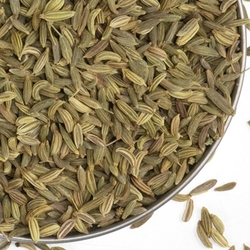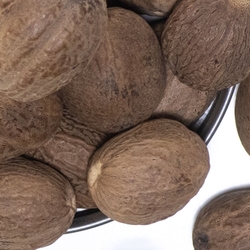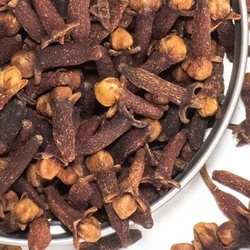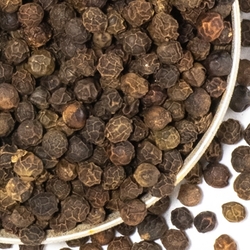Which Spices Do You Grind?

Whole spices are a favorite of cooks everywhere who like to have the freshest, most vibrant flavor in their foods. Whole spices are great. They usually keep for longer than their ground counterparts, since they lose less oil to the air than ground spices. This is because ground spices have more surface area exposed to the air, so their oils evaporate more rapidly. Pre-ground spices that you will find at the grocery store may also be exposed to the light and have become stale. You should always store spices in a cool, dark place. Usually the grocery store is rife with bright artificial lighting that actually damages the spices. If you are ready to begin your own spice grinding, the first move you should make is buying fresh, whole spices.
How to Use Whole Spices
Once you have bought your own whole spices there are a menagerie of ways to use them, depending on the type of spice and the type of dish you are making. You can keep your spices whole in some cases, though this usually works best if the dish is one that must simmer for a long time. We recommend adding whole spices early when cooking because it allows the full depth of their flavor to permeate the dish. If you are afraid of leaving while spices in food or you think they will be hard to find, you could tie them up in a cheesecloth for easier removal.
If you are looking for a earthier flavor in your spices, you can try toasting them. Toasting spices brings out a different, deeper flavor. You want to make sure you don't burn them, because they won't taste very good at all if they are burnt. You can save some foods after charring them, but not spices. Toast spices on a pan on low heat. After they have become fragrant, as in you can smell them noticeably, you should remove them from the pan even if they appear physically unchanged. Only toast one kind of a spice at a time. Each spice has a unique cook time and you don't want to burn your nutmeg while trying to scoop coriander seeds out of the pan.
How to Grind Whole Spices
When it comes to grinding your spices, you have a few options. If you only need a small amount, go for a mortar and pestle. We recommend using one that would hold 2-3 cups of ground spices so that you don't have ground spices flying all over the place. If you are planning on grinding a big amount or you've decided that grinding spices in your home will happen on a more regular basis, you may want to go for an electric spice grinder. Coffee grinders or nut grinders used specifically for spices will work, too. Some spices require they be ground, some require they remain whole. So, which spices do you grind?
Whole Spices to Keep on Hand and Grind When Needed
Don't cheat yourself out of the best flavor possible. If you use these spices, you could be grinding them and experiencing the most vibrant flavors your dishes can offer.
- Cloves - Cloves are very intense. Most frequently found in their whole form, studding savory dishes like pork or ham roasts, they can also be used in sweets when ground up and mixed with nutmeg, cinnamon, and ginger. They are very flavorful, even when used with other spices, so use sparingly!
- Fennel Seed - Fennel seed is at its best when it is added at the end of cooking a dish so it can give optimum flavor. It goes well with beets, lentils, potatoes, and stews. Meat dishes are also complimented by fennel seed. You will find that it also works quite well in combination with cinnamon, cumin, fenugreek and Sichuan peppercorns.
- Black Cardamom - This is a spice with a lot of popularity in Indian dishes, like rice pilafs or curries of all varieties. It has an intense smoky flavor which does well in dishes that require a long cooking time.
- Nutmeg - Nutmeg is often one of the first spices to cross a person's mind when they think about grinding spices. They are perfectly sized to fit in the hand and can even be grated on special nutmeg graters. When ground, nutmeg is used in many different baked goods such as cakes, cookies, and fruit pies. It can also be used to compliment soups and cheese dishes.
- Black Peppercorns - Whole black peppercorn produces a distinctly spicy flavor which is slightly hot and biting with a just a hint of sweetness. This is one of the most popular, most frequently used spices in the world. Once ground, black pepper goes well with eggs, fish, pork, chicken, salads, soup, strawberries and tomatoes.
Grinding Conversions
If you are grinding your own spices, you may find that you end up with more than you bargained for, especially if you have never ground spices before. Below we have listed some of the most commonly ground spices and their ground conversion rate, so you can have a general idea of what you'll be getting when you grind your spices for the first time.
- Allspice: One teaspoon of whole Allspice will yield about one teaspoon of ground allspice.
- Black Pepper: One teaspoon of peppercorns will yield about one and a half teaspoons of ground pepper.
- Cardamom: Twelve pods or so will yield one teaspoon of ground cardamom. The pods must be dehusked first, which means the pod has to be broken open to reveal the seeds inside. Usually there are about seven, and you should grind these seeds for the best flavor.
- Cinnamon: One stick that is about one and a half inches long will yield about one teaspoon of ground cinnamon.
- Cloves: Roughly twelve cloves will yield about a teaspoon of ground cloves.
- Coriander: One teaspoon of coriander seeds will yield roughly one and a quarter teaspoons of ground coriander.
- Cumin: One teaspoon of cumin seeds will yield approximately one and a quarter teaspoons of ground cumin.
- Fennel Seeds: One teaspoon will yield about one and a quarter teaspoons of ground fennel.
- Nutmeg: Half of the average sized nutmeg will yield about a teaspoon of ground nutmeg.
- Mustard Seeds: One teaspoon of mustard seeds will yield about one and a half teaspoons of ground mustard.
How to Clean a Grinder
To clean your grinder, pour a tiny amount of rice in, one to two tablespoons should do the trick, and grind it down to a powder. Wipe out the grinder with a damp cloth and let it air dry. If you do use a coffee grinder for your spices, keep a separate one for coffee. The flavor of coffee can often linger in a grinder and will alter the flavor of your spices drastically. Alternatively, the coffee beans may have a different flavor from the strong spices, too! Grinding spices is the best way to ensure you are getting the most flavor in your dish every time, so you want to maintain your grinder to ensure you will be able to use it for many moons to come. Now you have been thoroughly informed about the spices you can grind, so get to grinding!





